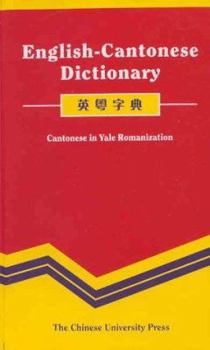English-Cantonese Dictionary: Cantonese in Yale Romanization
Select Format
Select Condition 
Book Overview
Over 15,000 of the most commonly used words and phrases; a brief introduction to Cantonese pronunciation in accordance with the Yale System of Romanization; a comparative chart of four systems of Romanization; and grammatical notes for beginners.
Format:Paperback
Language:English
ISBN:9622019706
ISBN13:9789622019706
Release Date:December 2000
Publisher:Chinese University of Hong Kong Press
Length:608 Pages
Weight:1.00 lbs.
Dimensions:1.1" x 4.0" x 6.8"
Grade Range:Postsecondary and higher
Customer Reviews
2 ratings
A handy guide
Published by Thriftbooks.com User , 16 years ago
This book's one short coming is that it does not include the Chinese characters to go with the Yale Romanized Cantonese words so that if you need to translate something you need another book. So it is a very good book for looking up the pronunciation of the Cantonese word you need, but of no help at all in translation of written characters. If I could afford only one book, it would be the Chinese?English version, but if I could have two books, this is a good addition.
If you're waiting for THE dictionary, buy, but keep waiting
Published by Thriftbooks.com User , 24 years ago
This dictionary just came out as a companion to the Yale-in-China Chinese to English dictionary. It has a lot of the charm of the earlier volume: waterproof cover, handy size, useful appendices on grammar and pronunciation, and broad vocabulary. The English is not excessively British, and there are a lot of idioms which are nicely translated into equivalent Cantonese phrases. That being said, there are several real problems:1. There are printing errors in the pronunciation section where the IPA symbol for Cantonese phoneme "s" is the IPA letter pronounced "sh"--a BAD error, especially for beginners, especially as Cantonese uses no "sh" sound.2. There are many English spelling errors, not such a big deal most times.3. Worse, there are errors in the Cantonese transliteration, putting in entirely wrong words by leaving out letters. This was a minor problem in the earlier Chinese-to-English book in only a few words. But when you're using the book to learn the pronunciation, such errors are especially annoying.4. English synonyms often have different Cantonese translations, for instance check out "maybe" and "perhaps"--this is a minor problem.5. There are no Chinese characters in this book. While it makes the printing a lot simpler, it hinders the mastery of phrases, not knowing the precise meaning of particles which are homonyms with identical English spelling and tone, but different connotations in Cantonese. If you want to write a translation, you're on your own! I'm not sure this was a great editorial decision.6. As always happens in a first edition, many idioms are lacking, but I can't complain too much about this.7. The books are somewhat flimsy--my copy of the earlier text is about 3 months old, and a section has already fallen out. For a reference book, this is not good.Overall, not a bad reference for pronunciation of Cantonese, with some useful grammar, but with significant flaws.






